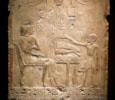Stele Of Sa-Pa-Ir
A stele in honour of Sa-pa-ïr, a soldier, dedicated by his brother the priest Men-Kheper. In limestone, with traces of blue, red, ochre and black pigment still visible. Chisel marks are present on the back and sides. On the left, seated on a lion-footed chair, is the dedicatee, Sa-pa-ïr. To the right is the dedicator, his brother Men-Kheper. A table laden with offerings is between them. Sa-pa-ïr wears a short, military wig, an usekh collar and a long loincloth. His left hand holds a folded cloth and is bent towards his chest; his right is extended out towards the offerings, signalling his acceptance of them. Men-Kheper, also wearing an usekh collar and loincloth but with a shaven head, raises his right hand over the offerings in a gesture of consecration. The hieroglyphics read: (above the figures) The soldier of His Majesty, Sa-pa-ir His brother, who keeps his name alive, the pure-priest Men-Kheper (above the offering table) His wife, Hor-em-ousekhet (under Sa-pa-ir’s chair) His daughter, Ti-her-Râe(?) (two lines at the base of the stele) Offering that the king gives to Osiris, sovereign of eternity, so that he may grant the offerings that are invoked orally: parts of cattle, poultry, clothing, incense, oils and all sorts of things good and pure, to the ka of His Majesty's soldier, Sa-pa-ir; by his brother who keeps his name alive, the pure-priest Men-Kheper. - The stele was discovered buried in the grounds of the Villa la Sapinière, on the island of Noirmoutier, Vendée, France in the 1920s, by the family who owned the villa. It then remained in the possession of the same family, at some point being moved to their mansion near Dijon. The discovery of an Egyptian object so far from Egypt can perhaps be explained by the ruins of a Roman villa on the island, as it is a documented fact that the Romans were known to bring back spoils and souvenirs from conquered lands and garrison towns, to which they accorded a value that was as exotic as it was talismanic or religious. However, there is no record of any Egyptian antiquities being discovered in the excavations of the Gallo-Roman villa, which began pre-1860s and were carried out by Edouard Richer, the then mayor of Noirmoutier, and the fact that it was discovered separately, in the grounds of a private residence, points to a different history. It is possible that someone in the past few hundred years, perhaps in the 18th century when interest in Egyptology became more widespread, purchased the stele and then, due to a change in personal circumstances, buried it for safekeeping. There are, for example, two Egyptian statues in the Louvre (nos. A 68-N 69 and A 91-N 94) which were discovered in the garden of a banker who was guillotined in 1793, and also a statue of the goddess Neith found during roadworks in 1902 in the Place de la Bastille, Paris, which had been published in 1793. Egyptologist Luc Gabolde, who examined the stele in 2001 and subsequently published it in the Revue D'Egyptologie, suggested to us that the fact that it was buried, whilst puzzling, could also be explained by the fact that Egyptian objects, and especially ones bearing seemingly magical symbols such as the eyes on this stele, were often credited with strange powers and that the family may have buried it for their own protection.
Luc Gabolde, ‘Une stèle au nom du soldat Sa-pa-ïr dédiée par son frère, le prêtre-pur Men-kheper’, Revue D'Egyptologie Publiée par la Société Française D'Egyptologie avec le Concours du Centre National de la Recherche Scientifique, Tome 62, 2011, pp. 199-202, pl. XXVI.
Reputedly from Abydos.
Previously in the Private Collection of Charles Maurice Darcy (6th July 1893 – 27th December 1940), officer in the French Air Force and war hero, discovered in the 1920s in France.
By descent to his son, Henri Darcy (1st February 1930 - 12th August 1953), officer in the French Air Force (accompanied by a note written by Henri Darcy following a meeting with Jean Leclant (1920-2011), famous archaeologist, discussing Leclant’s comments on the stele).
By descent to his sister, Jacqueline Darcy (11th March 1919 - 2017), who married M. Arnaud de Seze (22nd December 1907 – 10th December 1987).
By descent to their daughter, born Laurence de Seze (10th December 1949 – 22nd July 2009), who married M. Xavier de La Celle (b. 1st December 1948).
By descent to their children, the de La Celle family (accompanied by French Export License 229658).
ALR: S00218907, with IADAA Certificate, this item has been checked against the Interpol database.










 Enquire
Enquire




